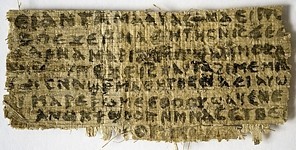 Last week, I posted my initial take on the so-called "Gospel of Jesus' Wife." My first point was that it was "too early to tell" whether the manuscript was genuine. In the last twenty years, forgers have produced some amazingly convincing forgeries, so scholars have become cautious about all archeological finds.
Last week, I posted my initial take on the so-called "Gospel of Jesus' Wife." My first point was that it was "too early to tell" whether the manuscript was genuine. In the last twenty years, forgers have produced some amazingly convincing forgeries, so scholars have become cautious about all archeological finds.
In the case of this Coptic fragment, the glaring immediate problem is that no one knows where it came from. The best way to be certain that an artifact is genuine is to have an archeological team document its discovery. Most of the recent forgeries have been released onto the antiquities black market. For the forger, this is an ideal way to make money, and it is much more difficult for anyone to verify the authenticity of the find. Many artifacts on the black market are genuine, but they are all suspect.
Now that photos of the manuscript have been circulating among experts for a few weeks, there are even more reasons to believe that it is a forgery. Although we probably won't have certainty for several months yet, here are the reasons that it is more likely that the "Gospel of Jesus' Wife" is a hoax:
- According to some paleographers (ancient writing analysts), the writing is shaky, as if the "scribe" did not actually know Coptic and was trying hard to imitate other ancient Coptic manuscripts.
- Francis Watson, a Coptic expert, has persuasively shown how the forger could have put together the manuscript by combining phrases and words from the Gospel of Thomas. Unfortunately for the forger, his limited ability in Coptic means that he made some grammatical mistakes in how he combined them.
- The majority of experts in the field who have examined the papyrus fragment are deeply suspicious or are even convinced that it is a fraud. Their skepticism is not based on issues of personal belief, since the various experts come from a variety of positions of belief and unbelief. Helmut Koester, Craig Evans, Francis Watson, and many other experts in the field all have serious doubts about the authenticity of the fragment. Reporters are having a hard time finding scholars who accept the find besides Karen King and AnneMarie Luijendijk (who contributed to the original article).
- Some insiders reported that the Harvard Theological Review rejected Karen King's article about the document because the authenticity of the fragment was too doubtful. The Review is now reporting that they will only accept the article after seeing the results of scientific tests on the manuscript's ink.
Now, it is still possible that something will persuade the experts that this ancient fragment is genuine. But even if it is "genuine," all that means is that the document was genuinely written by Gnostics - people who regularly made up sayings about Jesus to bolster their own religion. It still would be written centuries after Jesus, by people with no connection to the eyewitnesses.
 Biola University
Biola University
.jpg)


.jpg)